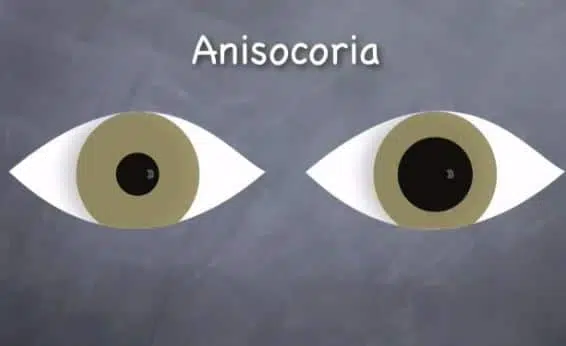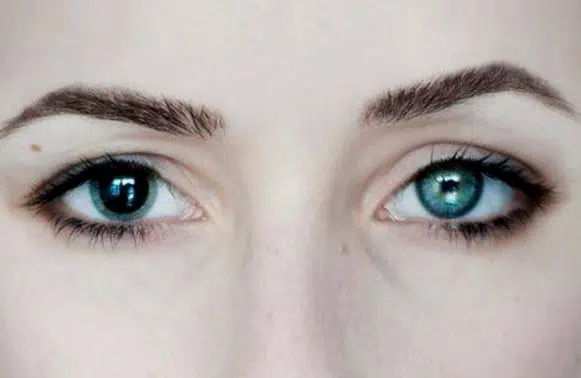What causes one pupil to be bigger than the other? Is it stress, anxiety, or headaches? Unevenly dilated pupils are referred to as anisocoria. They can make you look imbalanced, worried or even scary. What can you do about unequal pupils?
Pupils are the black center parts of your eyes, which become dilated (large) when in dim light, and constricted (smaller) when in bright light. Normally, both pupils should be of the same size, and should have the same response to light exposure. But, when you have unequal pupils, they are known as anisocoria.
If the sizes of your pupils are very unequal, there is a chance that you will notice this discrepancy. In many cases, unequal pupils are only noticed during an eye examination by a doctor. The unequal pupils will by themselves not cause any symptoms, even though you may occasionally experience a problem focusing on objects that are very close to you.
Additionally, the underlying disorder for anisocoria may at times cause more symptoms e.g.
- Redness and eye pain
- Drooping eyelids
- Loss of vision
- Headaches
- Double vision
Many people seek medical attention because of these more noticeable symptoms, rather than because of having one pupil bigger than the other. Read on to find out what causes one pupil bigger than the other, available treatment options, and whether it is possible to prevent it.
What is Anisocoria (Dilated or unequal pupils)?
Typically, the size of your pupils should be similar in each eye, and both eyes should constrict or dilate together. Anisocoria is a term used to refer to pupils that are of different sizes at any one time. Anisocoria can be because of an underlying medical condition or could be physiologic (normal).
According to HealthLine, approximately twenty percent of the world’s population has anisocoria. But, the amount present may vary from one day to the next, and it could also switch between your eyes. If anisocoria is not associated with or is not because of a medical condition is referred to as physiologic anisocoria. Normally, when it comes to physiologic anisocoria, the existing difference between the size of the pupils in both eyes will not exceed one millimeter.
Symptoms
According to WebMD, many people do not realize that their pupils are of different sizes until an eye exam is carried out. But, if anisocoria was to develop due to a problem with your eyes, you would likely notice symptoms such as:
- Fever
- Headaches
- Reduced sweating
- Drooping eyelids
- Problems when attempting to move your eyes
- Eye pain
Why is one pupil bigger than the other? Causes
The most common causes of one pupil being larger than the other include:
1. Dilated pupil
In a case where one pupil refuses to make a response to the dilating drops, there could be a number of possibilities. Your iris may be partially stuck to your lens due to prior surgery, trauma, or inflammation. A singly constricted pupil may be caused by ocular issues e.g. trauma or inflammation, but, it can also be related to the failure of your dilator muscle because of the presence of neurological conditions e.g. Horner’s syndrome.
This syndrome may be a benign condition, or it may be caused by a wide variety of issues e.g.
- Presence of a tumor in your chest
- Migraines
- Use of certain medications
- Carotid artery dissection
Additionally, the syndrome may also be congenital. There are certain medications and drops, which have been known to cause constricted pupils.
See also:
2. Concussion and unequal pupils
Sustaining blunt force trauma to the head is one of the primary causes of temporary anisocoria, which may occur due to:
- Sports related injuries e.g. rugby or American football
- Accidents e.g. automobile accidents
- Other violent events
A brain concussion can cause unequal pupils, more so if the injury you have sustains get to affect certain parts of your brain. In addition, if your skull comes to an abrupt stop, your brain may not only be injured in the side that has been impacted by the stop, but it may also end-up being damaged on the opposite side as it is bouncing back. It is also possible for your eye to be injured in a similar manner during the movement of your vitreous body.
Concussions are deemed to be dangerous by doctors, as they can cause brain tissue damage as well as associated swelling. Most people assume that black eyes are relatively minor. However, any person who has sustained an injury to the face or eye resulting in the black eye should be evaluated by an emergency physician through the use of CAT scans or X-rays in a bid to monitor the voluntary movements of the eyes, as well as rule out the possibility of any damage to the surrounding eye orbits and bones.
The bones found in this area are quite thin and can be broken very easily. As such, a blow to your eye could push your eyeball back into the space that is available behind it, which would result in the compression of the muscle tissue, and the fat filling this orbit. This would then make the fragile bones in the orbit to become fractured.
3. Anxiety and dilated pupils
Dilated pupils are likely to occur with any kind of anxiety, even though they are most common during the periods of deep anxiety, which can occur under the following conditions:
- Phobias
- Panic attacks/panic disorders
- PTSD
But, you should note that the dilated pupils can occur during any severe anxiety sessions. Typically, when the flight or fight response is functioning in a proper manner, it should only become activated during periods when you have intense fear e.g. times when you may need to fight or start running away. In such instances, your body will need to have great vision. It is the reason why your pupils start to dilate. When the pupils become dilated, the eyes start to let in more light, which means that your vision will temporarily become improved.
Is it possible to reduce pupil constriction?
Unlike all the other symptoms associated with anxiety attacks, you cannot be able to control pupil dilation. It is not possible to “talk your eyes down” to prevent dilation, and there are no exercises that you can conduct to prevent their dilation.
Your pupils form a part of your body that is 100% automatic, and therefore, when they change in size, you have no option but to wait for them to return to normal on their own. Controlling your anxiety is the only available treatment for pupil dilation.
If you constantly find that your pupils are dilated when dealing with an anxiety attack, the good news is that there are many techniques that you can use to effectively control your anxiety related symptoms.
4. Headaches
One pupil bigger than the other accompanied by headaches is often associated with Horner’s syndrome. In Horner’s syndrome, the headaches are said to be excruciating, unilateral, and highly throbbing, which can come at varied times.
On occurrence, they may refuse to subside, even when you attempt to avoid noise or light, or even have some rest. In addition to the throbbing headaches, your eyes could also become droopy and sunken. If you notice this, it is recommended that you visit your ophthalmologist for evaluation purposes.
5. Damage to your iris sphincter
Trauma can make your iris sphincter to become inflamed or affected. Your pupil has an irregular shape, and magnification will show that your iris muscles have become damaged.
6. Horner’s syndrome
This is a very rare disease, which comes about when specific nerves that travel from your eyes to your brain become damaged. Note that this is not a disease, but it is an indication that you have an underlying medical condition, which may include:
- Stroke
- Tumor
- Spinal cord injury
There may be instances where the causative factors are not known. In such cases, Horner’s syndrome will only affect one side of your face. Symptoms of the Horner’s syndrome include:
- Decreased pupil size
- Decreased sweating on one part of your face
- Presence of a loose eyelid
When these happens, the pupil that is affected will become smaller, and it may start reacting abnormally to changing light conditions.
7. Chemical blockade
Anisocoria is likely to occur in the event that Para sympatholytic chemicals come into direct contact with your Conjunctiva. It can affect the iris sphincter muscles, which would then make your pupil to expand and become very wide. It is a common occurrence among people who have been exposed to plants that contain Atropine.
8. Failure of your Parasympathetic
A breakdown of the parasympathetic will make your pupils to become dilated. Pupil dilation means that they will react very slowly to any light that they are exposed to.
In such a condition, you will need to be conscious about the third nerve palsy, which is mainly caused by aneurysm.
Diagnosis of Anisocoria
It is recommended that you contact your doctor immediately you notice one pupil bigger than the other. When you go for your appointment, the doctor will examine both eyes, and also take your vitals. At this point, ensure you discuss any other symptoms that you could have been experiencing. For instance, you need to speak out if you have any experienced any of the following recently:
- Eye pain
- Changes in your vision
- Light sensitivity
- Stiff neck
- Fever
Based on the symptoms described, and your existing medical history, additional tests could be ordered by your physician, to enable him/her diagnose the underlying cause of this problem.
For instance, the tests recommended could include:
- CT scans
- Eye exams
- Complete blood count
- Blood differential
- MRI
- X-ray
- Spinal tap or lumbar puncture
Treatment for unequal pupils
In many cases, anisocoria will not need to be treated as it does not affect your eye health or eyesight in any way. But, if the condition is related to a problem with your eyes, then this problem will need to be addressed, in order to eliminate the one pupil bigger than the other problem.
If you happen to have an abnormal growth e.g. a brain tumor, the doctor may recommend that you undergo surgery in order to have it removed. Chemotherapy and radiation therapy are alternatives to surgery, which can also be used in removing the brain tumor.
You can manage this condition by:
- Attempting to determine what is causing it. Keep in mind that there are very many conditions, which could be responsible
- If it has been caused by medication e.g. eye drops and asthma inhalers, ensure you avoid this medication
- If it has been caused by trauma, your physician may prescribe some medication to assist with the inflammation
Prevention
There are certain cases of anisocoria, which are not only impossible to predict, but they cannot be prevented as well. However, there are certain steps that can be taken in order to prevent the development of uneven pupils. For instance:
- Make sure you wear a helmet when you are playing contact sports
- Always wear your seatbelt when you are driving
- When using heavy machinery, ensure that you wear protective gear
- Report any changes in your vision to your physician
It is always recommended to ensure that you seek immediate medical assistance if you notice any differences in your pupil sizes. The physician will be able to identify the underlying cause of these differences and provide you with medication to assist you restore your vision.
Article Resources
- Mayo Clinic Staff. (2014, April 2). Concussion: Symptoms: http://www.mayoclinic.org/diseases-conditions/concussion/basics/symptoms/con-20019272
- Anisocoria and Horner’s syndrome. (2016, August): http://www.aapos.org/terms/conditions/27
- What is anisocoria? (2012, May 29): http://www.aao.org/eye-health/diseases/what-is-anisocoria
- Stanford University Opthalmology, (9:14 AM, SEPTEMBER 15, 2015) “Neuro-ophthalmology Question of the Week: Aberrant Regeneration of the 3rd Nerve



